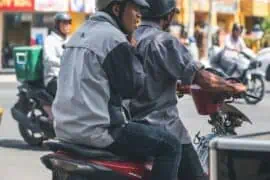Riding a motorcycle with a passenger for the first time was a scary experience for me. I hadn’t anticipated what the extra weight would do while riding, so I took a turn at the aggressive speed and angle I loved on the country road by my parent’s place.
Thankfully, my passenger was experienced and provided a counterbalance because he anticipated what I was doing. He also gave me a piece of his mind for taking that line once we got to where we were going.
Didn't You Try Our Quote Comparison Tool Yet? Save BIG by Doing it!
Riding a motorcycle with a passenger is a lot like it is when taking a trip alone. The extra weight can throw you off-balance unexpectedly, especially if that person sits further back than expected or shifts without telling you.
After that first incident, I got into the habit of briefing each passenger on what to expect. Then I ask if there’s something I need to know from them. By creating a dialogue early, we can enjoy the ride together safely.
Table of Content
Is It Hard to Ride a Motorcycle with a Passenger?
Riding a motorcycle with a passenger can be more challenging than being alone, but it can be done comfortably and safely with some practice. It is essential to use proper techniques going two-up to ensure both of you can have a great time.
When riding with a passenger, you’ll have several factors to consider that could change your style or approach. Here is an overview of what to expect as you set a motorcycle passenger safety guideline for passengers
Cornering
The extra weight may require you to lean the motorcycle more and adjust your body positioning accordingly when taking corners or curves. Ensure that both of you are comfortable with navigating them together.
Accelerating and Braking
With a passenger’s added weight, your acceleration and stopping capabilities change on a motorcycle. You’ll need to adjust the throttle and inputs according to allow for a more gradual change to ensure a smooth process.
Safety Gear and Seating
Make sure your motorcycle has an appropriate seating arrangement for a passenger, including a comfortable and secure seat, footpegs, and possibly a backrest. Both you and your passenger should wear safety gear like helmets, jackets, gloves, and boots. According to state law, these are the requirements for passengers in your state.
Riding with a passenger is a skill that improves with practice and experience. Start with short, low-traffic rides and gradually build up to longer trips as you become more comfortable.
How to Get On and Off a Motorcycle as a Passenger?
As a passenger, getting on and off a motorcycle requires coordination and following some basic steps to ensure safety.
Although every operator has specific preferences for this process, there are some general steps you can follow as a passenger to make this practice safe and effective.
- Before mounting the motorcycle, communicate with the rider to ensure they are ready and aware of your actions.
- Put on your helmet and any other protective gear required for the ride.
- Approach the motorcycle from the left side, where the kickstand is typically located.
- Swing your leg over the seat and position yourself directly behind the rider. Be careful not to kick or disturb motorcycle parts while performing this action.
- Once seated, hold onto the rider’s waist or the designated grab rails for more stability and balance.
- Place your feet on the passenger footpegs or the provided floorboard. Avoid resting your feet on the ground while the motorcycle is in motion, even slowly.
The process is similar when you’re ready to get off the motorcycle. I recommend maintaining a firm grip on the grab rails or the rider, waiting for the bike to come to a complete stop.
It’s essential to take your time with this process for safety reasons.
Once the motorcycle is still, you can swing your leg over the seat to dismount. Please stay clear of any parts because their surfaces could be hot and cause an injury.
Place your feet on the ground and maintain balance as you step away from the motorcycle. At this point, you can remove your protective gear.
What About Having a Child as a Motorcycle Passenger?
Riding a motorcycle with a child passenger requires even more caution and attention to ensure safety. That process starts with adequate seating.
Many bikes have options for installing a child seat. Kids should be able to reach the footpegs comfortably to sit in the saddle.
Then think about the comfort and endurance levels of the child. I recommend shorter trips and more frequent breaks to avoid restlessness.
Do You Lean into a Turn On a Motorcycle as a Passenger?
Yes, leaning into a turn on a motorcycle as a passenger can help with stability and balance.
When riding as a passenger, it is important to communicate and coordinate with the rider to ensure a smooth and safe experience. Leaning into the turn helps reduce the amount required from the motorcycle, keeping the center of gravity in the correct place for the operator.
This proper motorcycle passenger riding position helps the bike turn more effectively.
As a passenger, follow the operator’s lead and be attentive to their movements and signals to ensure a comfortable and safe ride.
FAQ About Motorcycle Passengers
If you’re considering riding with a passenger, you likely have some questions that need answers. Here are some of the common concerns that operators like you have and the information they need to make an informed decision.
How Old Do You Have to Be to Ride as a Passenger on a Motorcycle?
Most states do not have a minimum age requirement for motorcycle passengers. There is often a rule that says the passenger must be able to reach the footpegs or floorboard while having a dedicated seat for them, which makes it challenging for kids younger than five to qualify.
Arkansas, Hawaii, Louisiana, New York, Texas, and Washington have age restrictions for passengers between the ages of five and eight.
Always use your best judgment when riding with a passenger, especially young children. They must have the same safety gear as the operator and helmet laws likely apply.
How Long Should You Wait to Ride with a Passenger on a Motorcycle?
It helps to be confident as a motorcycle operator before taking a passenger. Please familiarize yourself with your bike’s handling, braking, and acceleration characteristics to the point they become second nature.
Then review the weight limits for your make and model. Ensure your motorcycle is designed and capable of carrying an additional passenger safely.
Different jurisdictions may have specific requirements regarding the licensing and experience needed to carry a passenger. There could be additional restrictions if you’re still on a learning permit.
Do Motorcycle Passengers Need to Be Aware of Traffic Laws?
Passengers play a role in ensuring their safety and that of others on the road while riding with an operator.
Motorcycles follow all traffic laws, though California allows lane splitting, and other states have bike-specific rules.
In some jurisdictions, passengers can also be held responsible for certain violations, such as not wearing a helmet where required or interfering with the operator’s control of the motorcycle.
It isn’t necessary to have an in-depth knowledge of all traffic laws. A general understanding of basic rules, signs, and signals can contribute to a safer and more enjoyable ride.
Can I Carry a Pillion Passenger with a Learning Permit?
You are not typically permitted to carry a passenger with a learning permit. If you can operate two-up, a licensed rider must accompany you on their bike within a specific distance.
Taking a basic rider course or safety class is usually easier when you have a learning permit. If you pass the course exam, you can typically go right to the skills test. There could be written and visual tests to pass as part of the licensing process.
Use This Tool for Free and Save on Quotes!






